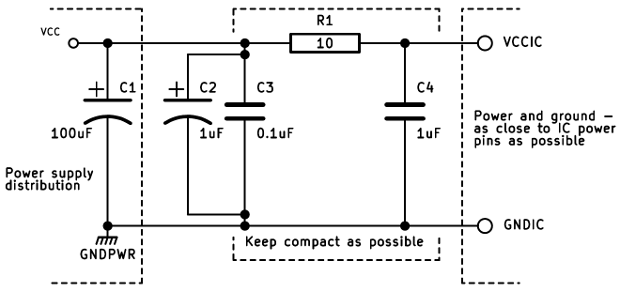

Current Project: Many analog designs fail because the circuit layout didn't take into consideration the effect that insufficient power distribution has on noise, accuracy and general reliable performance.
The Power Supply To A Given Circuit Are Its Most Important Signals...
Designers often forget how important isolation and response of the power is to the performance, and accuracy, of high resolution analog circuits. This is generally a failure to recognize how much transient energy is flowing and how much impedance the power (signal) paths represent leading to poor performance in many 'avoidable' ways.
All active electronic circuits require power. Knowing this, individually, these components use the best design practices to reject the influence that power supply noise and variation has on circuit performance. But this ability can only be carried so far. And that's where good circuit layout comes in.
All Power and Ground signals to an individual (single function) circuit should be as low an impedance as possible from the circuits point of view. All noise and transient fluctuations on these signals will translate directly to circuit behavior.
DeCoupling Power Signals V+, V-, etc...
Here's where using capacitors and or resistors/inductors to decouple, or filter, a signal (the power supply) can be very useful. Always use a capacitor at every power junction (node). Furthermore isolate sub-circuits with a small resistor and capacitor (filter). The two principals here are lowering the impedance into the circuit while increasing the impedance to anything else attached to the power signal reducing the circuits individual transient influence too and from other sub-circuits (reflection) A.K.A. Cooperation.

What's going on here.... The two local input capacitors C2,C3 help account for the inductive component of the power supply signal. Inductance doesn't respond well to fast transient changes in current but the capacitors do. It is important to keep them as close to the target circuit as possible. The reason that there are two capacitors is that the two types provide different but complimentary response to rapid changes in current keeping the impedance low and the Voltage stable at those nodes (junctions). The resistor R1 provides slight isolation for the primary power signal. With the addition of the final capacitor C4 the circuit is additionally isolated from effects of the power signal caused by other sub-circuits using the same power supply. The transient demands are also less burden on the power supply signal as other sub-circuits see it.
Choosing the right components also makes a difference. For the Electrolytic capacitor I prefer Tantalum and the other two Multilayer Ceramic. For the resistor I prefer an inductive Wire-Wound. You really don't get much inductance but the little there is contributes to good performance. They are also cheap and the lowest noise type available. The whole purpose here is to supply a 'very' low noise, low impedance, power reference for an active circuit. If a circuits power supply can gain a mere 20db better fidelity it can improve noise and distortion levels by orders of magnitude. Simply by better layout techniques.
Ground Is The Most Important Signal In An Analog Circuit...
Many signal errors (distortion) in both reproduction and measurement can be attributed to bad grounding. Always consider ground as having a dual role as a power supply signal (return) and as 'The' reference point for a given circuit.
Conclusion...
Uh!
3143